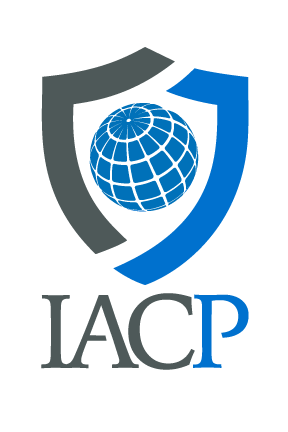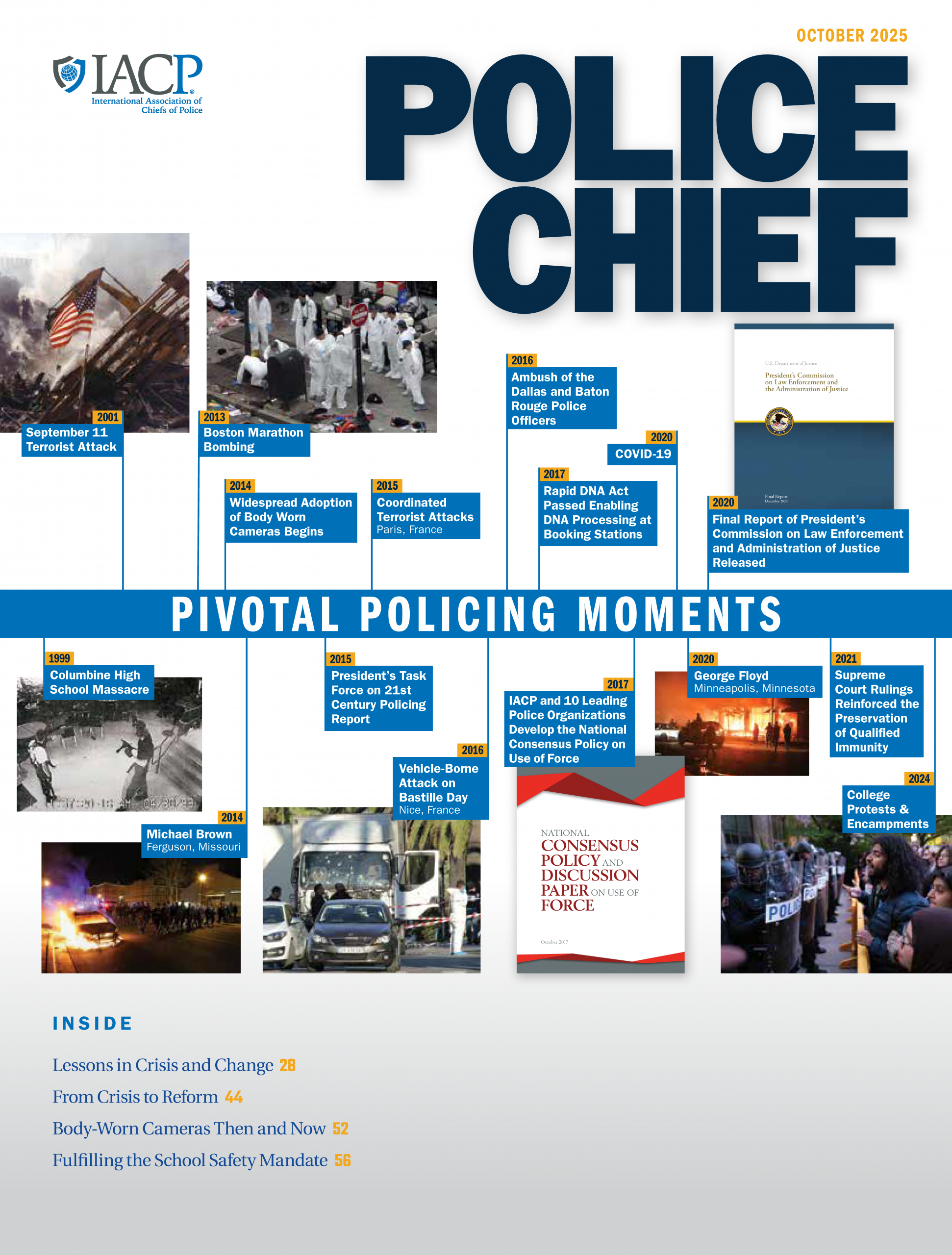What does it mean to be an effective leader in the law enforcement profession today? How do effective leaders make decisions?
IACP defines leadership as the process of influencing human behavior to achieve organizational goals that serve the public, while developing individuals, groups, and the organization for future service. IACP promotes the concept of dispersed leadership, which means that every officer is a leader. Leaders at every level of a law enforcement organization have a responsibility to connect individual, group, and organizational behavior with defined values.
In order to help all law enforcement professionals develop the skills to become more effective leaders, IACP offers a suite of evidence-based leadership training programs uniquely tailored to the law enforcement profession. The material taught during these trainings provides a road map for law enforcement leaders to better understand effective leadership and to implement policies and practices that promote positive outcomes across the organization. These courses teach participants how to analyze leadership situations, explain problems, and develop actions to reinforce what is going well and address what is not. The first way IACP trainers teach class participants to do this is by employing the Leader Thought Process, a systematic approach to making effective decisions.
The Leader Thought Process

Employing the Leader Thought Process requires the accomplishment of four objectives. First, one must recognize circumstances that compel leaders to act. Second, one must use what is known from behavioral science to analyze and explain why those circumstances exist. Third, one must formulate a leader action plan to address the circumstance at hand. Finally, one must devise an assessment tool to determine the effectiveness of his or her actions.
The Leader Thought Process comprises four key steps:
• Step I: Identify What Is Happening
• Step II: Account for What Is Happening (i.e., why is something occurring?)
• Step III: Formulate Leader Actions
• Step IV: Evaluate and Assess
Step I: Identify What Is Happening
What are the circumstances compelling you to act? A leader must observe a specific problem, opportunity, or decision. For example, a problem may take the form of unsatisfactory performance, while an opportunity may take the form of an employee proposing a promising new initiative for the organization to consider. Identifying the correct circumstance or behavior may be difficult, so be specific and separate these observations into definable issues that can stand alone.
Step II: Account for What Is Happening
Once the issue has been identified, a leader must seek to account for what is happening. One way to do this is by creating a logical chain of events. Try to arrange the events in sequential order, highlighting any cause-effect relationships. Next, analyze and explain that chain of events using theories—included in IACP leadership training curricula—and experiences.
Finally, identify the root cause. If the circumstance is a problem, the root cause is the fundamental issue underlying the problem. If the circumstance is an opportunity, the root cause is the underlying motivation for the individual inquiring about or pursuing said opportunity. Much like a medical situation, treating the symptoms may help in the short term, but it likely won’t cure the illness. So how does a leader know what the root cause is? To correctly identify the root cause of a circumstance, ask if the identified cause is a potential cause of all other related circumstances. When a cause is identified, one should continue to ask “why?” There might be a more deeply rooted cause. If a tangential or triggering cause is identified and addressed, but the primary cause remains, then the same issues might continue to arise—and might even worsen.
Step III: Formulate Leader Actions
After the theory that accounts for what is happening has been identified, one should choose the best theoretical leader strategy. Using the identified theory and its recommendations for action, implement an action plan that addresses all circumstances being caused by the root cause. The action plan must describe what the leader will do, to whom, when, how, where, and so forth. The leader plan should not create new problems or allow major problems to go uncorrected, but it should also be realistic to implement in the organization.
Step IV: Evaluate and Assess
Evaluate the success of the leader action plan and make adjustments as necessary. How has the plan impacted the situation? This might include questions such as
• What kind of information do I need?
• From whom will I obtain it?
• In what form should I collect the information?
• How frequently do I collect it and for how long?
The information collected during the evaluation phase should be as specific as possible. Besides gauging the effectiveness of the leader plan, this step also helps pinpoint any new issues or circumstances that the leader might need to address. Leaders should reflect and decide if they would make the same decision and implement the same action plan again in the future. If not, what would they do differently?
Conclusion
Why does this matter? As current or aspiring leaders move through an organization and take on new responsibilities, it’s important that they review and refine their leadership skills as they relate to their new positions in their organizations. Tomorrow’s chiefs of police are today’s aspiring supervisors.
IACP is committed to shaping the future of the profession through leadership development. The Leader Thought Process provides the foundation for both the IACP’s First-Line Leadership (FLL) and Leadership in Police Organizations (LPO) curricula. The Leader Thought Process is an effective leadership tool to identify and analyze problems, opportunities, and decisions within law enforcement organizations. It is a critical starting point for leaders seeking a consistent, evidence-based decision-making process. IACP introduces FLL and LPO participants to the Leader Thought Process and provides implementation strategies relevant to each promotional stage of an officer’s career, which in turn reinforces sustained professional development.
First-Line Leadership
FLL is IACP’s three-day leadership development training program geared toward current or aspiring leaders. The course helps new leaders understand their roles as supervisors and provides tangible techniques to assist them in tackling their new responsibilities. Topics covered in this training include toxic leadership, transformational leadership, effective communication, emotional intelligence, critical thinking and problem-solving, procedural justice, followership, and more. By the end of this course, attendees should have a set of strategies and tools to call upon when making decisions, inspiring followers, and achieving organizational goals. Learn more at theIACP.org/First-Line-Leadership.
Leadership in Police Organizations
LPO is IACP’s flagship leadership development training program, adapted in 2009 from the West Point leadership curriculum to address the needs of law enforcement. LPO is a three-week training that takes place one week a month over the course of three consecutive months. Week one examines leading individuals, week two examines leading groups, and week three examines leading organizations. The training includes lessons on critical thinking and problem-solving, understanding individual differences and human bias, intrinsic and extrinsic motivation, goal setting, emotional intelligence, leading ethical organizations, change management, and more. By the end of this academically rigorous course, participants should be able to understand and apply modern behavior science and leadership theories to their everyday leadership practices and decision-making. Learn more at theIACP.org/LPO.
How to Attend an IACP Leadership Training
How To Attend an IACP Leadership Training: IACP currently offers two methods of receiving FLL and LPO training. The first is an agency-hosted training, and the other is our IACP-sponsored training.
Agency-Hosted Training: Agencies, counties, and public safety professional organizations can purchase the entire course and fill all 36 available seats. This is a closed course only available to the agency or organization’s sworn and non-sworn employees. All training takes place at a venue provided by the host agency or organization.
IACP-Sponsored Training: Individuals can register for an IACP-sponsored training at a per-person registration fee. These courses will be offered multiple times a year and are open to all sworn and non-sworn law enforcement professionals seeking leadership development.
Note
1 IACP, Leadership in Police Organizations, Vol. 1 (Alexandria, VA: IACP, 2009).


